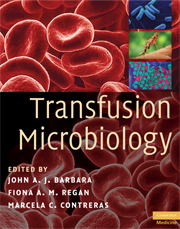Book contents
- Frontmatter
- Contents
- List of contributors
- Foreword
- Preface
- Acknowledgements
- Glossary
- Introduction: Transfusion-transmitted infections, then and now
- Section 1 Agents
- Section 2 Selection and testing
- 10 Blood donor selection and qualification
- 11 Current serological methods of testing and automation
- 12 Confirmatory testing and donor re-admission
- 13 The strategy for applications of nucleic acid testing
- 14 Nucleic acid testing: general view
- 15 Nucleic acid testing: the US approach
- 16 Nucleic acid testing: the UK approach
- 17 Quality in the screening of donations for transfusion-transmissible infections
- 18 Microbiological blood testing and new technologies
- 19 Processing and components: leucodepletion and pathogen reduction
- 20 Fractionated products
- Section 3 Surveillance, risk and regulation
- Index
- Plate section
- References
17 - Quality in the screening of donations for transfusion-transmissible infections
from Section 2 - Selection and testing
Published online by Cambridge University Press: 12 January 2010
- Frontmatter
- Contents
- List of contributors
- Foreword
- Preface
- Acknowledgements
- Glossary
- Introduction: Transfusion-transmitted infections, then and now
- Section 1 Agents
- Section 2 Selection and testing
- 10 Blood donor selection and qualification
- 11 Current serological methods of testing and automation
- 12 Confirmatory testing and donor re-admission
- 13 The strategy for applications of nucleic acid testing
- 14 Nucleic acid testing: general view
- 15 Nucleic acid testing: the US approach
- 16 Nucleic acid testing: the UK approach
- 17 Quality in the screening of donations for transfusion-transmissible infections
- 18 Microbiological blood testing and new technologies
- 19 Processing and components: leucodepletion and pathogen reduction
- 20 Fractionated products
- Section 3 Surveillance, risk and regulation
- Index
- Plate section
- References
Summary
Introduction
The field of transfusion microbiology has developed rapidly over the last 20 years. However, not only has the field developed in terms of the understanding of the biology and science of the infectious agents, the advent of automated mass screening systems, and the increased general focus on the microbial safety of blood and blood products, but importantly the overall quality – the reliability and effectiveness of screening has improved significantly. This quality improvement has come from a number of sources:
The identification of those transmissible infectious agents of most concern for transfusion
A more detailed and comprehensive understanding of the biology of transmissible agents
The development of sensitive assays for transmissible agents
The improvements in assay design, including the inclusion of specific features to monitor the step-by-step performance of the assay
The introduction of quality management systems into blood transfusion services (BTSs)
The development of appropriate automation
The introduction of licensing/accreditation of BTSs
The introduction of haemovigilance systems.
Overall, it is the amalgamation of the above elements into a single seamless system that has resulted in the current overall high level of safety of the blood supply in most countries with developed health care systems. Nonetheless, it must be understood that these systems are not always as robust as one would wish, and vigilance is necessary to ensure that quality standards are maintained. In addition, the potential threat of new, as yet unidentified, agents must not be forgotten.
- Type
- Chapter
- Information
- Transfusion Microbiology , pp. 217 - 226Publisher: Cambridge University PressPrint publication year: 2008



